Australia is better known for its vast desert outback, venomous spiders, kangaroos, koalas, and great white sharks than its lofty peaks, but some of its mountains reach impressive altitudes. Discover the highest point in New South Wales, which also holds the title for the highest point in mainland Australia.
What Is the Highest Point in New South Wales?
Mount Kosciuszko is the highest point in New South Wales, Australia, at 7,310 feet (2,228 meters) tall.
This lofty peak is around 100 miles inland from the southeastern coast of Australia in the Snowy Mountains of Kosciuszko National Park.
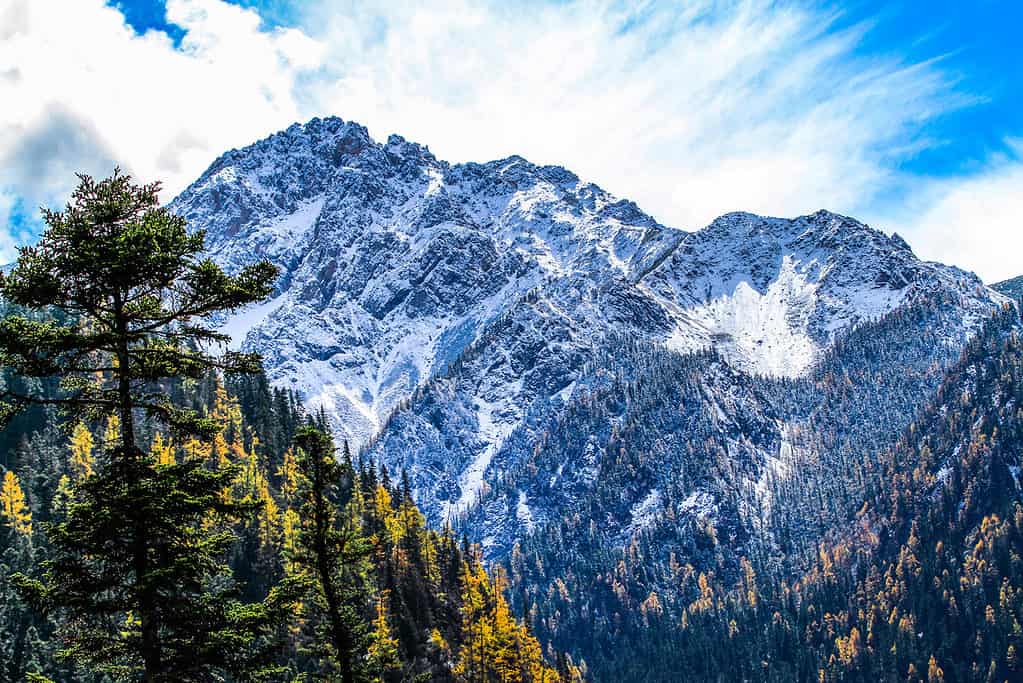
Mount Kosciuszko is the highest point in New South Wales.
©iStock.com/chengwaidefeng
About Mount Kosciuszko
Mount Kosciuszko is a peak in the Australian Alps mountain range. It was named by a Polish explorer called Paul Strzelecki in 1840 in honor of General Tadeusz Kosciuszko, a Polish-Lithuanian-American freedom fighter.
It’s pronounced Koz-ee-US-ko, or the more Polish-sounding Kosh-USH-co, but in recent years, indigenous Australian groups have pushed for an indigenous name. In 2019, Kunama Namadgi, meaning “snow” and “mountain,” was suggested.
How Was Mount Kosciuszko Formed?
Geological uplift created Mount Kosciuszko, rather than ancient volcanoes or continental collisions.
Geological uplift occurs when the Earth’s tectonic plates push together and move the surface’s crust upwards to form mountains. Experts believe the Australian Alps formed 50 million years ago.
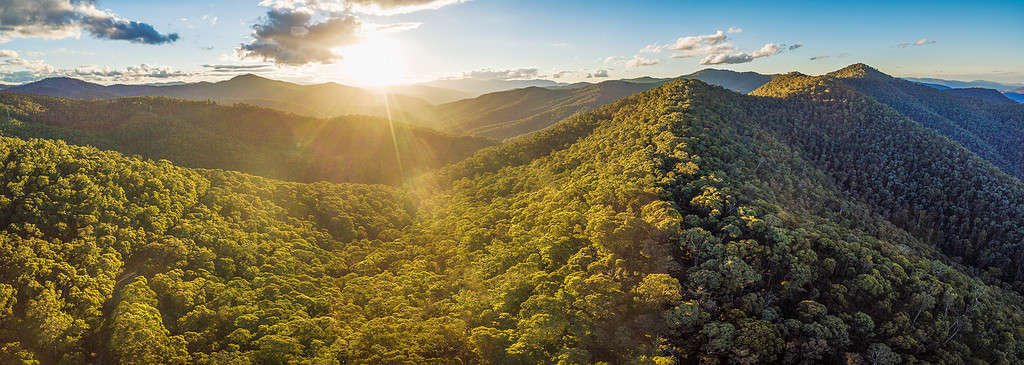
Mount Kosciuszko is part of the Australian Alps.
©Greg Brave/Shutterstock.com
The Highest Points in New South Wales
Mount Kosciuszko is New South Wales’ highest point, but only just because other epic mountains are lurking close behind. Here are the top five tallest mountains in New South Wales.
- Mount Kosciuszko: 7,310 feet (2,220 meters)
- Mount Townsend: 7,247 feet (2,209 meters) is just short of Mount Kosciuszko but craggier with a more defined peak.
- Mount Twynam: 7,201 feet (2,195 meters) sits just five miles northeast of Kosciuszko.
- Rams Head: 7,190 feet (2,190 meters). This peak sits in the Rams Head range of the Snowy Mountains.
- Carruthers Peak: 7,037 feet (2,145 meters) Close to Mount Twynam, it’s also spelled Curruthers Peak.
Most of Australia’s highest points are situated in New South Wales due to its Snowy Mountain range. Other high spots include the Victoria Alps, part of the Great Dividing Range that separates the central lowlands from the eastern highlands.
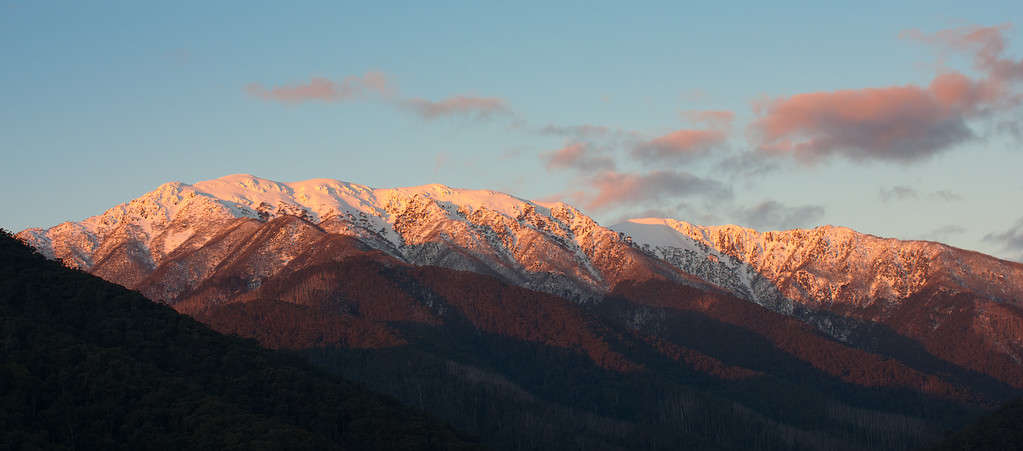
The Victoria Alps separate the central lowlands from the eastern highlands.
©Ashley Whitworth/Shutterstock.com
Is Mount Kosciuszko the Highest Point in Australia?
Yes, Mount Kosciuszko is the highest point in New South Wales, and it’s also the tallest point in mainland Australia. The highest point in Australian territory is actually 11,450 feet (3,490 meters) tall Mount McClintock in the Australian Antarctic Territory.
However, despite its victorious title, Mount Kosciuszko is not one of the world’s tallest peaks. It’s dwarfed by the world’s highest point, 29,032 feet Mount Everest in Asia.
Here’s how it compares to other continent’s mountains around the globe:
- South America: Mount Aconcagua at 22,837 feet
- North America: Mount Denali at 20,310 feet
- Europe: Mount Elbrus at 18, 510 feet
- Africa: Mount Kilimanjaro 19,341 feet
- Antarctica: Mount Vinson 16,050 feet
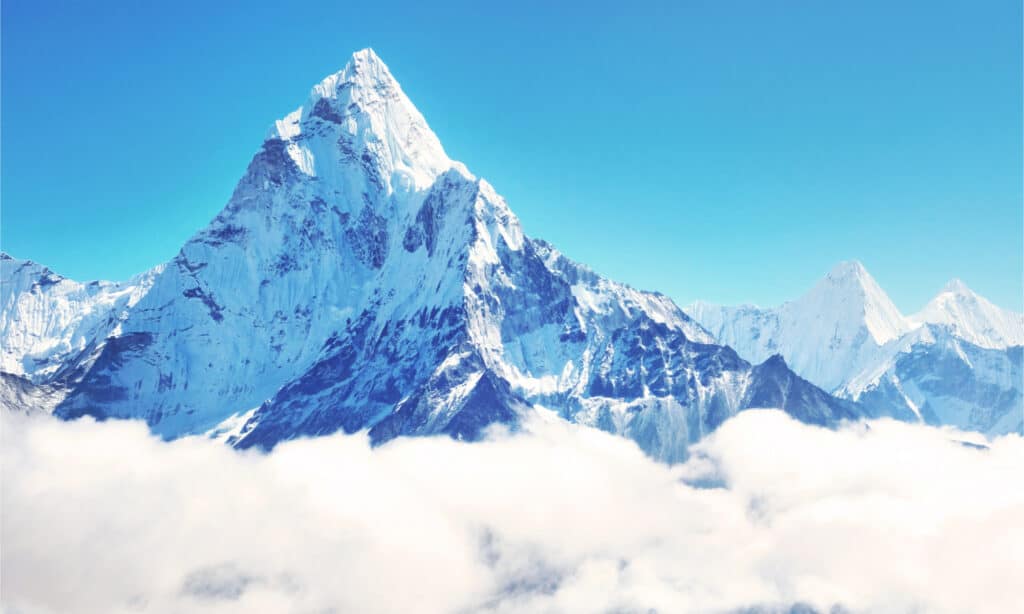
Mountain Everest is the highest mountain in the world.
©Vixit/Shutterstock.com
How Long Does It Take to Climb Mount Kosciuszko?
It takes an average hiker four to five hours to climb Mount Kosciuszko. As mountain hikes go, it’s an easier one. The best time to ascent New South Wales’s highest point is spring to summer when wild alpine flowers bloom and the snows melt away. In Australia, this is from December through to March.
Most hikers take the Kosciuszko Express Chairlift and complete the eight-mile walk from there, winding past Lake Cootapatamba, Australia’s highest lake. Another more dubious title claimed by Mount Kosciuszko is that of Australia’s highest public toilet – a bunker-like building dug out of the mountainside at Rawlins Pass just a few hundred feet below the summit!
Another popular route is the Summit Walk from Charlotte Pass. This route is just over 11 miles and takes six to eight hours.
Hardened hikers might like to try a third walk on the Main Range track. This tough ascent passes glacial Blue Lake and Hedley Tarn through a Unesco-protected biosphere reserve.

Many easy-to-hike trails run across Mount Kosciuszko.
©Greg Brave/Shutterstock.com
How Do You Get to the Top of Mount Kosciuszko?
Up until 1977, it was possible to drive to Mount Kosciuszko’s summit, but officials closed the road due to pollution and environmental degradation concerns. Today, its 100,000 annual visitors take the chairlift and hike to the top.
The mountain is not remote. Visitors can drive to Thredbo’s ski village park and choose various paths to the summit or more scenic routes with less elevation.
Where Is It on a Map?
Mount Kosciuszko is on the main range of New South Wales’ Snowy Mountains. It’s west of Crackenback, near the border with Victoria, and close to a town called Jindabyne.
Mount Kosciuszko Animals
New South Wales’ highest point is part of Kosciuszko National Park, which is Australia’s largest park. It’s filled with rare plants and animals, and its slopes feature rare alpine ecosystems that form just 0.001% of the Australian landmass. It’s no wonder Kosciuszko National Park is a protected area in Australia.
Some of the endangered animals on Mount Kosciuszko include the Guthega skink, the highest-living skink in Australia! It only lives at 5,249 feet altitude in the alpine regions of Kosciuszko National Park and the Victoria Alps.
They are rare, but you might also spot endangered Northern or Southern Corroboree frogs, alpine tree frogs, alpine water skinks, alpine she-oak skinks, and the alpine spiny crayfish.
Here are some of the more common animals winding their way through the park’s myriad ecosystems and around Mount Kosciuszko.
Feral Horses
Better known as brumbies, feral horses are the offspring of European settlers’ imported horses. They first arrived in 1788, and upwards of 10,000 now live in the park. Although they’re well-loved by many, their overwhelming presence causes eco-degradation and threatens native species by trampling and compacting waterways.
Brumbies don’t have natural predators in Australia, although wild dogs or dingoes prey on foals.
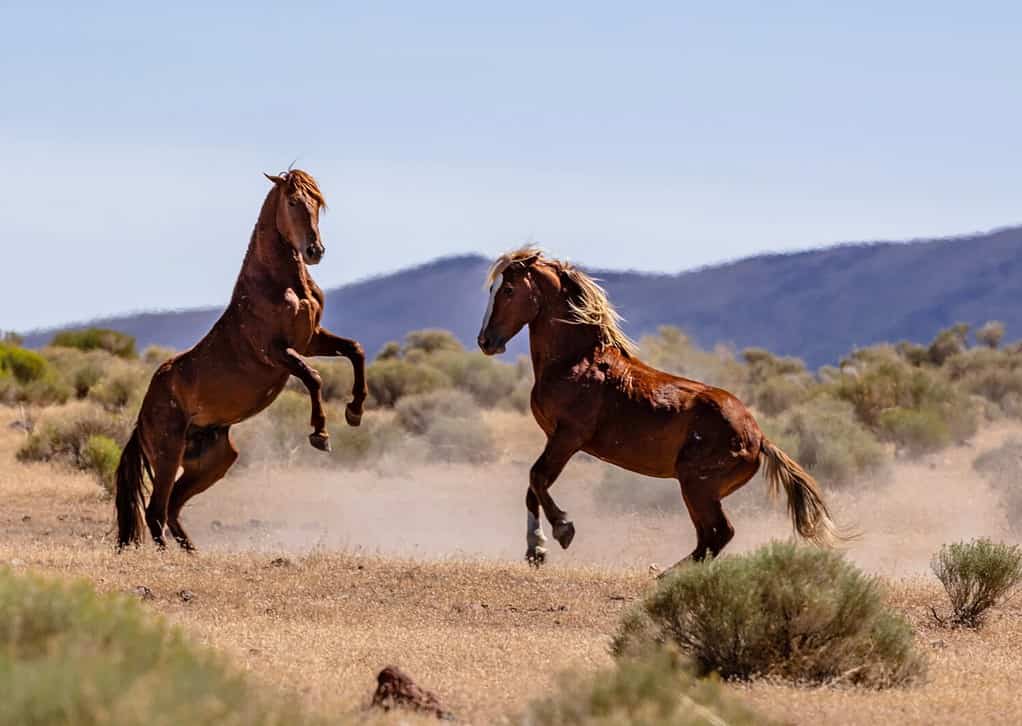
Australia’s wild horses are called brumbies. They descended from European settlers’ imported horses.
©Que Images/Shutterstock.com
Platypus
In the permanent lakes and river systems of Kosciuszko National Park, shy platypuses emerge in the early morning and or late evening to hunt larvae and insects with their sensitive bills. These amphibious mammals have duck-like bills, webbed feet, and flat tails to stealthily propel through the water.
Despite their official mammal status, females lay one to three eggs in spring! Platypuses are monotremes, which are very rare egg-laying mammals. Along with the echidna, they’re the only two egg-laying mammals on Earth.

A platypus lays eggs even though it is a mammal.
©Martin Pelanek/Shutterstock.com
Short-beaked Echidna
Reclusive short-beaked echidnas were called spiky anteaters due to their habit of munching ants and other insects. They tend to emerge from burrows in the late evening or early morning to hunt out their favorite insect prey using electro-location and long, spiky tongues.
Like platypuses, echidnas are egg-laying mammals, but they’re covered in keratin spikes to fend off predators like dingoes and wild dogs. Beneath their spiky armor, female echidnas have pouches to incubate their eggs.
Echidna’s have the lowest body temperature of any mammals, and their adorable babies are called puggles!

Short-beaked echidna babies are called puggles.
©pelooyen/iStock via Getty Images
Eastern Brown Snake
Australia is known for its animals that threaten humans, and the eastern brown snake is one of them!
This fairly bland-looking seven-foot-long snake is brown with a pale yellow belly, but it’s one of the world’s most toxic snakes. It preys on mice, lizards, and birds, and although its venom is deadly to humans, eastern brown snakes are shy. They hide from humans, so deaths are rare.
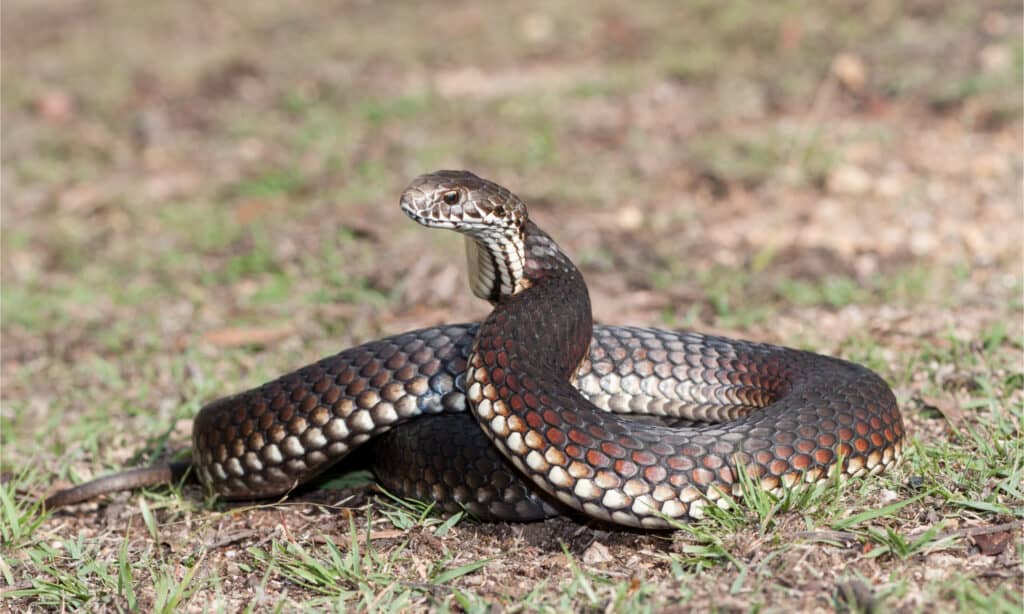
Eastern brown snakes are among the world’s most venomous.
©Ken Griffiths/Shutterstock.com
Other animals on New South Wales’s highest point include:
- Red-necked wallaby
- Spotted grass frog
- Eastern striped skink
- Koala
- Wolf spider
- Lace monitor
- Dingo
- Wild dog
- Grey kangaroo
- Lyrebird
- European fallow deer
- Wild boar
- Red-bellied black snake
Recap on New South Wales’ Highest Mountain
The highest point in New South Wales is the 7,310-foot-tall Mount Kosciuszko. It sits in the Australian Alps of southeast Australia within the Kosciuszko National Park.
It’s nowhere near the tallest mountain in the world. Still, this breathtaking area of Australia provides epic skiing, hiking, fishing, camping, caving, and horse riding, plus homes for a wide range of animals, from endangered skinks to deadly snakes and wild brumbies.
The photo featured at the top of this post is © Greg Brave/Shutterstock.com
Thank you for reading! Have some feedback for us? Contact the AZ Animals editorial team.






